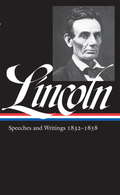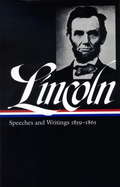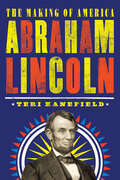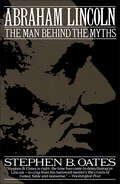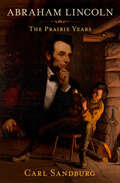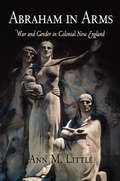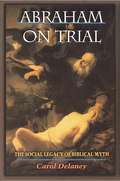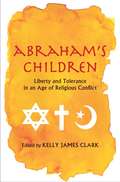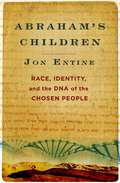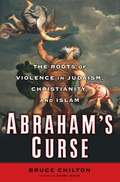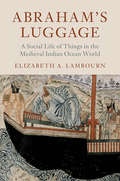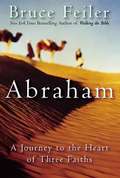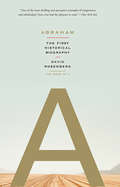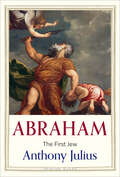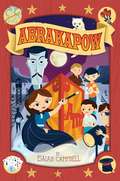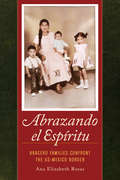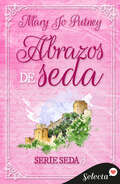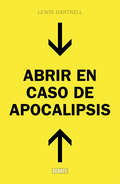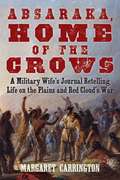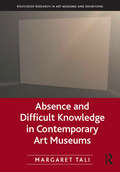- Table View
- List View
Abraham Lincoln: Speeches & Writings 1832-1858
by Abraham LincolnWith over 100,000 copies in print, here, with a new jacket for Lincoln's bicentennial, is the first volume in The Library of America's acclaimed, comprehensive edition of Lincoln's writings, featuring 240 speeches, letters, and drafts charting his rise from rural law practice to national prominence. It includes the full texts of the famous Lincoln-Douglas debates and the House Divided speech, as well as a detailed chronology of Lincoln's life and helpful explanatory notes prepared by the late Lincoln scholar Don E. Fehrenbacher. ?The companion volume, also available in a bicentennial edition, is Abraham Lincoln: Speeches and Writings 1859-1865.
Abraham Lincoln: Speeches & Writings 1859-1865 (Library of America Abraham Lincoln Edition #2)
by Abraham LincolnThe library of America is dedicated to publishing America's best and most significant writing in handsome, enduring volumes, featuring authoritative texts. Hailed as the "finest-looking, longest-lasting editions ever made" (The New Republic), Library of America volumes make a fine gift for any occasion. Now, with exactly one hundred volumes to choose from, there is a perfect gift for everyone.
Abraham Lincoln: The Making Of America #3 (The Making of America)
by Teri KanefieldThis biography for young readers examines the life of the sixteenth U.S. president and the constitutional issues that arose during his administration.Praise by many as America’s greatest president, Abraham Lincoln guided the country through the Civil War and was the Great Emancipator who freed the enslaved and paved the way for the Thirteenth, Fourteenth, and Fifteenth Amendments. Lincoln was denounced by others as a tyrant who trampled the Constitution, denied individual liberty, and failed to avert the war that left more than six hundred thousand American soldiers dead.Born in a cabin deep in the backwoods of Kentucky, growing up in a family considered “the poorest of the poor,” Lincoln rose to become a highly respected lawyer and stateman. He often used different arguments with different people depending on the needs of the moment, leading one exasperated opponent to call him two-faced, and leaving others to marvel at his effectiveness as a politician and leader.A practical statesman and not an idealist, Abraham Lincoln knew he could not accomplish all he set out to do, but he remained alert for opportunities to achieve his long-desired objective of liberty and justice for all.The book includes selections of Lincoln’s writing, a bibliography, and an index.“This concise and balanced narrative encapsulates the life and legacy of one of the country’s most important leaders. . . . A solid addition for understanding America’s story.” —Kirkus Reviews“The author adroitly reviews the facts of Lincoln's entire life, divided into 16 chapters, and examines his emergence as a politician and his views on slavery.” —School Library Journal
Abraham Lincoln: The Man Behind the Myths
by Stephen B. OatesA biographical study of the 16th U.S. president, and an essential book for any student of Lincoln and American history.In this multifaceted portrait, Oates, “the most popular historical interpreter of Lincoln” (Gabor S. Boritt, New York Times Book Review), exposes the human side of the great and tragic president—including his depression, his difficulties with love, and his troubled and troubling attitudes about slavery—while also confronting the many legends that have arisen around “Honest Abe.” Oates throughout raises timely questions about what the Lincoln mythos reveals about the American people.Praise for Abraham Lincoln“There is no better introduction to current thinking about Lincoln and his place in history. . . . Oates, author of the best one-volume biography of Lincoln of our time, scales Lincoln down to human size yet solidifies his reputation as one of our greatest presidents. . . . Oates’ Lincoln fascinates. He is both flawed human being and genuine hero.” —Newsday“Oates re-creates the life and world of Abraham Lincoln with the skill of a master painter. He succeeds in portraying both the facts and myths of history as essential to our understanding it.” —Christian Science Monitor
Abraham Lincoln: The Prairie Years (American Roots Series)
by Carl SandburgThis definitive, single-volume edition of the Pulitzer Prize–winning biography delivers &“a Lincoln whom no other man . . . could have given us&” (New York Herald Tribune Book Review).Celebrated for his vivid depictions of the nineteenth-century American Midwest, Carl Sandburg brings unique insight to the life of Abraham Lincoln in this distinguished biography. He captures both the man who grew up on the Indiana prairie and the president who held the country together through the turbulence and tragedy of the Civil War.Based on a lifetime of research, Sandburg&’s biographywas originally published as a monumental, six-volume study. The author later distilled the work down to this single-volume edition that is considered by many to be his greatest work of nonfiction.
Abraham Lincoln: The Prairie Years and the War Years (Volume II, The War Years 1861-1864)
by Carl SandburgHe was a natural to write a biography of the prairie president. Sandburg has his roots there as well, and understood the plain speech, the wry humor, and the hard work. His portrayal of Lincoln had a quiet dignity about it and kept to the point, which was to describe how Lincoln grew up, read the law, took his ethics into the city, ran for office, waged war, and died just before he got to the promised land. Later biographies have emphasized Lincoln's psychology, or the rigors of his personal life, but Sandburg's portrait comes from two people of the prairie, himself and Lincoln.
Abraham Lincoln: The Prairie Years and the War Years (Volume III, The War Years 1864-1865)
by Carl SandburgThe War years, 1864-1865, examines the bitter election of 1864, the conclusion of the War, the evolution of Lincoln's reconstruction policy, and finally the terrible assassination. Concluding volume of the 3-volume set.
Abraham in Arms
by Ann M. LittleIn 1678, the Puritan minister Samuel Nowell preached a sermon he called "Abraham in Arms," in which he urged his listeners to remember that "Hence it is no wayes unbecoming a Christian to learn to be a Souldier." The title of Nowell's sermon was well chosen. Abraham of the Old Testament resonated deeply with New England men, as he embodied the ideal of the householder-patriarch, at once obedient to God and the unquestioned leader of his family and his people in war and peace. Yet enemies challenged Abraham's authority in New England: Indians threatened the safety of his household, subordinates in his own family threatened his status, and wives and daughters taken into captivity became baptized Catholics, married French or Indian men, and refused to return to New England.In a bold reinterpretation of the years between 1620 and 1763, Ann M. Little reveals how ideas about gender and family life were central to the ways people in colonial New England, and their neighbors in New France and Indian Country, described their experiences in cross-cultural warfare. Little argues that English, French, and Indian people had broadly similar ideas about gender and authority. Because they understood both warfare and political power to be intertwined expressions of manhood, colonial warfare may be understood as a contest of different styles of masculinity. For New England men, what had once been a masculinity based on household headship, Christian piety, and the duty to protect family and faith became one built around the more abstract notions of British nationalism, anti-Catholicism, and soldiering for the Empire.Based on archival research in both French and English sources, court records, captivity narratives, and the private correspondence of ministers and war officials, Abraham in Arms reconstructs colonial New England as a frontier borderland in which religious, cultural, linguistic, and geographic boundaries were permeable, fragile, and contested by Europeans and Indians alike.
Abraham on Trial: The Social Legacy of Biblical Myth
by Carol DelaneyAbraham on Trial questions the foundations of faith that have made a virtue out of the willingness to sacrifice a child. Through his desire to obey God at all costs, even if it meant sacrificing his son, Abraham became the definitive model of faith for the major world religions of Judaism, Christianity, and Islam. In this bold look at the legacy of this biblical and qur'anic story, Carol Delaney explores how the sacrifice rather than the protection of children became the focus of faith, to the point where the abuse and betrayal of children has today become widespread and sometimes institutionalized. Her strikingly original analysis also offers a new perspective on what unites and divides the peoples of the sibling religions derived from Abraham and, implicitly, a way to overcome the increasing violence among them. <P><P>Delaney critically examines evidence from Jewish, Christian, and Muslim interpretations, from archaeology and Freudian theory, as well as a recent trial in which a father sacrificed his child in obedience to God's voice, and shows how the meaning of Abraham's story is bound up with a specific notion of fatherhood. The preeminence of the father (which is part of the meaning of the name Abraham) comes from the still operative theory of procreation in which men transmit life by means of their "seed," an image that encapsulates the generative, creative power that symbolically allies men with God. The communities of faith argue interminably about who is the true seed of Abraham, who can claim the patrimony, but until now, no one has asked what is this seed. Kinship and origin myths, the cultural construction of fatherhood and motherhood, suspicions of actual child sacrifices in ancient times, and a revisiting of Freud's Oedipus complex all contribute to Delaney's remarkably rich discussion. She shows how the story of Abraham legitimates a hierarchical structure of authority, a specific form of family, definitions of gender, and the value of obedience that have become the bedrock of society. The question she leaves us with is whether we should perpetuate this story and the lessons it teaches.
Abraham's Children
by Kelly James ClarkScarcely any country in today's world can claim to be free of intolerance. Israel and Palestine, Northern Ireland, Sudan, the Balkans, Pakistan, India, Sri Lanka, and the Caucasus are just some of the areas of intractable conflict apparently inspired or exacerbated by religious differences. Can devoted Jews, Christians, or Muslims remain true to their own fundamental beliefs and practices, yet also find paths toward liberty, tolerance, and respect for those of other faiths? In this vitally important book, fifteen influential practitioners of the Abrahamic religions address religious liberty and tolerance from the perspectives of their own faith traditions. Former president Jimmy Carter, Rabbi Arik Ascherman, Indonesia’s first democratically elected president, Abdurrahman Wahid, and the other writers draw on their personal experiences and on the sacred writings that are central in their own religious lives. Rather than relying on "pure reason," as secularists might prefer, the contributors celebrate religious traditions and find within them a way toward mutual peace, uncompromised liberty, and principled tolerance. Offering a counterbalance to incendiary religious leaders who cite Holy Writ to justify intolerance and violence, the contributors reveal how tolerance and respect for believers in other faiths stand at the core of the Abrahamic traditions.
Abraham's Children: Race, Identity, and the DNA of the Chosen People
by Jon EntineCould our sense of who we are really turn on a sliver of DNA? In our multiethnic world, questions of individual identity are becoming increasingly unclear. Now in ABRAHAM'S CHILDREN bestselling author Jon Entine vividly brings to life the profound human implications of the Age of Genetics while illuminating one of today's most controversial topics: the connection between genetics and who we are, and specifically the question "Who is a Jew?" Entine weaves a fascinating narrative, using breakthroughs in genetic genealogy to reconstruct the Jewish biblical tradition of the chosen people and the hereditary Israelite priestly caste of Cohanim. Synagogues in the mountains of India and China and Catholic churches with a Jewish identity in New Mexico and Colorado provide different patterns of connection within the tangled history of the Jewish diaspora. Legendary accounts of the Hebrew lineage of Ethiopian tribesmen, the building of Africa 's Great Zimbabwe fortress, and even the so-called Lost Tribes are reexamined in light of advanced DNA technology. Entine also reveals the shared ancestry of Israelites and Christians. As people from across the world discover their Israelite roots, their riveting stories unveil exciting new approaches to defining one's identity. Not least, Entine addresses possible connections between DNA and Jewish intelligence and the controversial notion that Jews are a "race apart." ABRAHAM'S CHILDREN is a compelling reinterpretation of biblical history and a challenging and exciting illustration of the promise and power of genetic research.
Abraham's Curse
by Bruce ChiltonWhen they arrived at the place which God had indicated to him, Abraham built an altar there, and arranged the wood. Then he bound his son and put him on the altar on top of the wood. Abraham stretched out his hand and took the knife to kill his son . . . ” —The Book of Genesis
Abraham's Luggage: A Social Life of Things in the Medieval Indian Ocean World (Asian Connections)
by Elizabeth A. LambournFrom a single merchant's list of baggage begins a history that explores the dynamic world of medieval Indian Ocean exchanges. This fresh and innovative perspective on Jewish merchant activity shows how this list was a component of broader trade connections that developed between the Islamic Mediterranean and South Asia in the Middle Ages. Drawing on a close reading of this unique twelfth-century document, found in the Cairo Genizah and written in India by North African merchant Abraham Ben Yiju, Lambourn focuses on the domestic material culture and foods that structured the daily life of such India traders, on land and at sea. This is an exploration of the motivations and difficulties of maintaining homes away from home, and the compromises that inevitably ensued. Abraham's Luggage demonstrates the potential for writing challenging new histories in the accidental survival of apparently ordinary ephemera.
Abraham's Well
by Sharon Ewell FosterFictionalized account of a young girl's experience on the Trail of Tears. Christian Historical Fiction.
Abraham: A Journey to the Heart of Three Faiths
by Bruce FeilerWhen the world is asking "Can the religions get along?" Abraham stands as the shared ancestor of Jews, Christians, and Muslims. He holds the key to our deepest fears-and our possible reconciliation.
Abraham: The First Historical Biography
by David RosenbergThe world's major religions-Judaism, Christianity, and Islam-find a common root in one man: Abraham. Yet Abraham looms so large in the realm of world religions that he has remained a ward of the Divine rather than a flesh-and-blood citizen of Humanity. In his monumental new book, David Rosenberg provides a long-overdue history of the patriarch; while revealing that the original story embedded in the Bible is actually our oldest historical biography. We also discover that the wandering ascetic of tradition cannot explain our deep-seated feelings for Abraham and his God. The road that Abraham traveled was marked by signs of civilization that we still recognize: libraries, museums, hotels, and houses of worship. He is a sophisticated, educated Sumerian; an artisan who became the first Jew. Moreover, through Rosenberg's audacious translation of the Abraham story from Genesis, we learn that many of the core tenets of the monotheistic tradition-the idea of God's covenant and the soul-are Sumerian in origin. Rosenberg first finds Abraham at his father's workshop in the cosmopolitan city of ancient Ur and follows his journey through what is today the Middle East. What kind of baggage-emotional, material, and spiritual-would Abraham have taken with him on his migration to a new land?Abrahamdoes more than present a founding spiritual figure and his dynamic relationships with father, wife, and son. We witness this man as he transforms his heritage into an anxious embrace of religion with secular culture-the human condition in which we are still enfolded today.
Abraham: The First Jew (Jewish Lives)
by Anthony JuliusThe story of Abraham, the first Jew, portrayed as two lives lived by one person, paralleling the contradictions in Judaism throughout its history In this new biography of Abraham, Judaism&’s foundational figure, Anthony Julius offers an account of the origins of a fundamental struggle within Judaism between skepticism and faith, critique and affirmation, thinking for oneself and thinking under the direction of another. Julius describes Abraham&’s life as two separate lives, and as a version of the collective life of the Jewish people. Abraham&’s first life is an early adulthood of questioning the polytheism of his home city of Ur Kasdim until its ruler, Nimrod, condemns him to death and he is rescued, he believes, by a miracle. In his second life, Abraham&’s focus is no longer on critique but rather on conversion and on his leadership over his growing household, until God&’s command that he sacrifice his son Isaac. This test, the Akedah (or &“Binding&”), ends with another miracle, as he believes, but as Julius argues, it is also a catastrophe for Abraham. The Akedah represents for him an unsurpassed horizon—and in Jewish life thereafter. This book focuses on Abraham as leader of the first Jewish project, Judaism, and the unresolvable, insurmountable crisis that the Akedah represents—both in his leadership and in Judaism itself.
AbrakaPOW
by Isaiah Campbell Dave PerilloBased on a true World War II story, Isaiah Campbell tells a charming mystery about a mishap at a magic show at a POW camp--featuring magic how-to diagrams throughout.Try as she might, cheeky middle schooler Maxine Larousse (you may call her Max "La Roo" or The Amazing Max, if you'd like) has yet to learn the one magic trick she needs the most: how to reappear in New York City. That is where she used to live with her parents before her father, Major Larousse, was put in charge of a Nazi POW camp in Abilene, Texas. At least in this desolate wasteland she'll have plenty of time to practice her illusions, even if the only audience member is her ferret Houdini. When she's tasked with entertaining the Nazi prisoners with a magic show, the pressure may be too much. But with the help of some classmates and an unexpected magic expert, the performance is a hit--until twelve Nazis escape during her final act. Will she be able to track them down before her reputation as a magician is destroyed forever?
Abrazando el Espíritu
by Dr Ana Elizabeth RosasStructured to meet employers' needs for low-wage farm workers, the well-known Bracero Program recruited thousands of Mexicans to perform physical labor in the United States between 1942 and 1964 in exchange for remittances sent back to Mexico. As partners and family members were dispersed across national borders, interpersonal relationships were transformed. The prolonged absences of Mexican workers, mostly men, forced women and children at home to inhabit new roles, create new identities, and cope with long-distance communication from fathers, brothers, and sons. Drawing on an extraordinary range of sources, Ana Elizabeth Rosas uncovers a previously hidden history of transnational family life. Intimate and personal experiences are revealed to show how Mexican immigrants and their families were not passive victims but instead found ways to embrace the spirit (abrazando el espíritu) of making and implementing difficult decisions concerning their family situations--creating new forms of affection, gender roles, and economic survival strategies with long-term consequences.
Abrazos de seda (Seda #Volumen 3)
by Mary Jo PutneyVibrante, apasionante y conmovedora... Última entrega de la «Trilogía de la seda». Después de haber sido liberado de su horrible cautiverio en Asia Central, el comandante Ian Cameron regresa a la India soñando con recuperar su vida. Sin embargo, no tarda en averiguar que lo dieron por muerto y que lo ha perdido casi todo. Una herencia inesperada le ofrece la oportunidad de volver a Escocia, su país natal, y empezar una nueva vida, pero primero quiere satisfacer el último deseo de un oficial ruso que conoció durante el cautiverio: llevarle a su sobrina, Laura Stephenson, que fue adoptada por un buen hombre inglés, su diario. Laura es hermosa y sensual, la promesa de un futuro mejor, algo que para Ian parecía imposible, de manera que se apresurará a proponerle matrimonio. Sin embargo, antes de regresar a Escocia han de emprender un peligroso viaje para que la joven recupere las posesiones de su tío, en el que descubrirán que su amor es más profundo y apasionado de lo que jamás se habrían atrevido a soñar.
Abrir en caso de apocalipsis: Guía rápida para reconstruir la civilización
by Lewis Dartnell"Una mirada fascinante a los principios básicos de las principales tecnologías que sostienen la sociedad contemporánea" Wall Street Jounal Una pandemia incontrolable, el impacto de un meteorito, o quizá una guerra nuclear; por el motivo que sea, el mundo que conocemos ha desaparecido y los escasos supervivientes deben comenzar de cero. ¿Cuáles son los conocimientos fundamentales necesarios para reconstruir nuestra civilización? Tras recoger lo poco lo poco que queda, ¿cómo se puede empezar a producir lo esencial? ¿Cómo cultivar alimentos, generar electricidad, preparar medicinas o extraer metal de las rocas? ¿Se puede evitar una nueva edad oscura y aprovechar los atajos para conseguir de nuevo el desarrollo? La vida en las sociedades contemporáneas nos han desconectado de los procesos básicos que nos sostienen, así como de las elegantes premisas científicas que permiten aprender las cosas por uno mismo. "Abrir en caso de apocalipsis" es un viaje de exploración, un libro que explica todo lo que hay que saber acerca de todo lo que nos rodea. Una guía rápida para reiniciar la civilización que transformará nuestra comprensión del mundo, y nos ayudará cuando este ya no exista.
Abroad (Penguin Specials)
by Penelope LivelyA brilliantly funny original short story from Booker Prize winning author Penelope Lively.'Anyone artistic needed Abroad in the 1950s.'Paul and his girlfriend are artists in need of subject matter. Arresting, evocative subject matter. So they decide to go Abroad, as much as possible, for as long as possible. Because Abroad is full of well furnished scenery. Particularly peasants. Real, earthy, traditional peasants. Except you shouldn't really call them peasants should you? 'Country people'. Abroad is full of country people.In this funny, deftly written short story, Penelope Lively satirises an arty student of the 50s, a precursor of the gap year traveller, who hasn't learnt as much from her time Abroad as she likes to think . . .Penelope Lively is the author of many prize-winning novels and short-story collections for both adults and children. She has twice been shortlisted for the Booker Prize: once in 1977 for her first novel, The Road to Lichfield, and again in 1984 for According to Mark. She later won the 1987 Booker Prize for her highly acclaimed novel Moon Tiger. Her other books include Going Back; Judgement Day; Next to Nature, Art; Perfect Happiness; Passing On; City of the Mind; Cleopatra's Sister; Heat Wave; Beyond the Blue Mountains, a collection of short stories; Oleander, Jacaranda, a memoir of her childhood days in Egypt; Spiderweb; her autobiographical work, A House Unlocked; The Photograph; Making It Up; Consequences; Family Album, which was shortlisted for the 2009 Costa Novel Award, and How It All Began. She is a popular writer for children and has won both the Carnegie Medal and the Whitbread Award. She was appointed CBE in the 2001 New Year's Honours List, and DBE in 2012. Penelope Lively lives in London.
Absaraka, Home of the Crows: A Military Wife?s Journal Retelling Life on the Plains and Red Cloud?s War
by Margaret CarringtonThe classic journal and firsthand account of one of the most disastrous military battles of the American frontier.On July 17, 1866, two soldiers and six wagoners were killed by Sioux Indians. In the next two weeks, fourteen more men died in Sioux attacks. The attacks continued through the summer and fall. On December 21, disaster struck. Recklessly pursuing Indians across a wooded ridge, Brevet Lieutenant Colonel William Fetterman and his company fell into an ambush. It was the worst military blunder of the Indian Wars before the Battle of the Little Bighorn ten years later.Margaret Irvin Carrington, like many officers' wives, kept a journal of her stay in the outposts of the West. She recorded her impressions of the scenery and the inhabitants of Absaraka, in present-day Wyoming, Montana, and the western Dakotas. As the wife of the commander of Fort Phil Kearny, Colonel Henry B. Carrington, she experienced the sequence of events and the heightening of tensions that led to that bloody December day. She could not have known that her journal would come to such a shocking climax, with her husband's career at stake. Today, her journal has been reprinted several times over to present this exciting, eye-opening view into life on the plains as the wife of an officer.
Absaraka, Home of the Crows: Being the Experience of an Officer's Wife on the Plains
by Margaret Irvin Carrington"With acknowledgments to Lieutenant-General Sherman, whose suggestions at Fort Kearney, in the spring of 1866, were adopted, in preserving a daily record of the events of a peculiarly eventful journey, and whose vigorous policy is as promising of the final settlement of Indian troubles and the quick completion of the Union Pacific Railroad as his "March to the Sea' was signal in crushing the last hope of armed rebellion, this narrative is respectfully dedicated. MARGRET IRVIN CARRINGTON.
Absence and Difficult Knowledge in Contemporary Art Museums (Routledge Research in Art Museums and Exhibitions)
by Margaret TaliThis book analyzes practices of collecting in European art museums from 1989 to the present, arguing that museums actualize absence both consciously and unconsciously, while misrepresentation is an outcome of the absent perspectives and voices of minority community members which are rarely considered in relation to contemporary art. Difficult knowledge is proposed as a way of dealing with absence productively. Drawing on social art history, museology, postcolonial theory, and memory studies, Margaret Tali analyzes the collections of four modern and contemporary art museums across Europe: the Hamburger Bahnhof in Berlin, the Ludwig Museum of Contemporary Art in Budapest, the Kiasma Museum in Helsinki, and the Kumu Museum in Tallinn.
